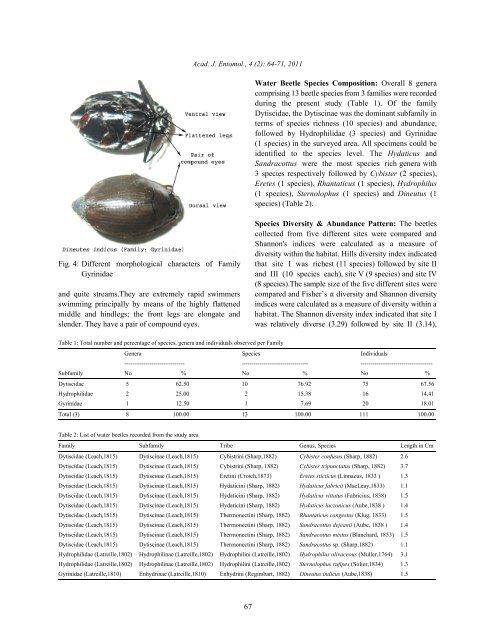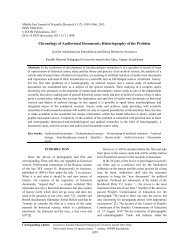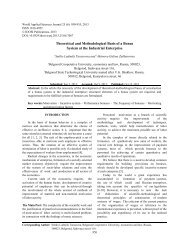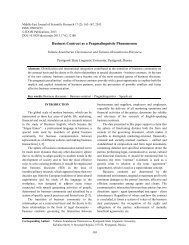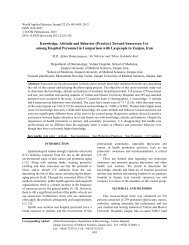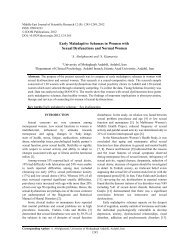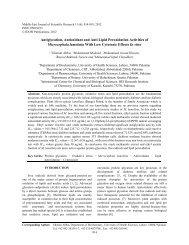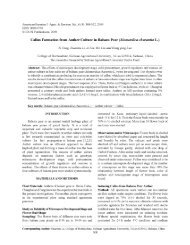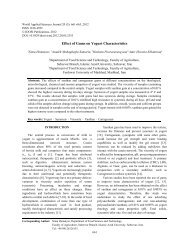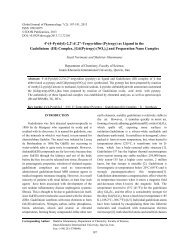Diversity, Abundance and Species Composition of Water ... - Idosi.org
Diversity, Abundance and Species Composition of Water ... - Idosi.org
Diversity, Abundance and Species Composition of Water ... - Idosi.org
Create successful ePaper yourself
Turn your PDF publications into a flip-book with our unique Google optimized e-Paper software.
Acad. J. Entomol., 4 (2): 64-71, 2011<br />
<strong>Water</strong> Beetle <strong>Species</strong> <strong>Composition</strong>: Overall 8 genera<br />
comprising 13 beetle species from 3 families were recorded<br />
during the present study (Table 1). Of the family<br />
Dytiscidae, the Dytiscinae was the dominant subfamily in<br />
terms <strong>of</strong> species richness (10 species) <strong>and</strong> abundance,<br />
followed by Hydrophilidae (3 species) <strong>and</strong> Gyrinidae<br />
(1 species) in the surveyed area. All specimens could be<br />
identified to the species level. The Hydaticus <strong>and</strong><br />
S<strong>and</strong>racottus were the most species rich genera with<br />
3 species respectively followed by Cybister (2 species),<br />
Eretes (1 species), Rhantaticus (1 species), Hydrophilus<br />
(1 species), Sternolophus (1 species) <strong>and</strong> Dineutus (1<br />
species) (Table 2).<br />
<strong>Species</strong> <strong>Diversity</strong> & <strong>Abundance</strong> Pattern: The beetles<br />
collected from five different sites were compared <strong>and</strong><br />
Shannon's indices were calculated as a measure <strong>of</strong><br />
diversity within the habitat. Hills diversity index indicated<br />
Fig. 4: Different morphological characters <strong>of</strong> Family that site I was richest (11 species) followed by site II<br />
Gyrinidae<br />
<strong>and</strong> III (10 species each), site V (9 species) <strong>and</strong> site IV<br />
(8 species).The sample size <strong>of</strong> the five different sites were<br />
<strong>and</strong> quite streams.They are extremely rapid swimmers compared <strong>and</strong> Fisher’s diversity <strong>and</strong> Shannon diversity<br />
swimming principally by means <strong>of</strong> the highly flattened indices were calculated as a measure <strong>of</strong> diversity within a<br />
middle <strong>and</strong> hindlegs; the front legs are elongate <strong>and</strong> habitat. The Shannon diversity index indicated that site I<br />
slender. They have a pair <strong>of</strong> compound eyes. was relatively diverse (3.29) followed by site II (3.14),<br />
Table 1: Total number <strong>and</strong> percentage <strong>of</strong> species, genera <strong>and</strong> individuals observed per Family<br />
Genera <strong>Species</strong> Individuals<br />
------------------------------- ---------------------------------- -------------------------------------<br />
Subfamily No % No % No %<br />
Dytiscidae 5 62.50 10 76.92 75 67.56<br />
Hydrophilidae 2 25.00 2 15.38 16 14.41<br />
Gyrinidae 1 12.50 1 7.69 20 18.01<br />
Total (3) 8 100.00 13 100.00 111 100.00<br />
Table 2: List <strong>of</strong> water beetles recorded from the study area<br />
Family Subfamily Tribe Genus, <strong>Species</strong> Length in Cm<br />
Dytiscidae (Leach,1815) Dytiscinae (Leach,1815) Cybistrini (Sharp,1882) Cybister confusus (Sharp, 1882) 2.6<br />
Dytiscidae (Leach,1815) Dytiscinae (Leach,1815) Cybistrini (Sharp, 1882) Cybister tripunctatus (Sharp, 1882) 3.7<br />
Dytiscidae (Leach,1815) Dytiscinae (Leach,1815) Eretini (Crotch,1873) Eretes sticticus (Linnaeus, 1833 ) 1.3<br />
Dytiscidae (Leach,1815) Dytiscinae (Leach,1815) Hydaticini (Sharp, 1882) Hydaticus fabricii (MacLeay,1833) 1.1<br />
Dytiscidae (Leach,1815) Dytiscinae (Leach,1815) Hydaticini (Sharp, 1882) Hydaticus vittatus (Fabricius, 1838) 1.5<br />
Dytiscidae (Leach,1815) Dytiscinae (Leach,1815) Hydaticini (Sharp, 1882) Hydaticus luczonicus (Aube,1838 ) 1.4<br />
Dytiscidae (Leach,1815) Dytiscinae (Leach,1815) Thermonectini (Sharp, 1882) Rhantaticus congestus (Klug, 1833) 1.5<br />
Dytiscidae (Leach,1815) Dytiscinae (Leach,1815) Thermonectini (Sharp, 1882) S<strong>and</strong>racottus dejeanii (Aube, 1838 ) 1.4<br />
Dytiscidae (Leach,1815) Dytiscinae (Leach,1815) Thermonectini (Sharp, 1882) S<strong>and</strong>racottus mixtus (Blanchard, 1853) 1.5<br />
Dytiscidae (Leach,1815) Dytiscinae (Leach,1815) Thermonectini (Sharp, 1882) S<strong>and</strong>racottus sp. (Sharp,1882) 1.1<br />
Hydrophilidae (Latreille,1802) Hydrophilinae (Latreille,1802) Hydrophilini (Latreille,1802) Hydrophilus olivaceous (Muller,1764) 3.1<br />
Hydrophilidae (Latreille,1802) Hydrophilinae (Latreille,1802) Hydrophilini (Latreille,1802) Sternolophus rufipes (Solier,1834) 1.3<br />
Gyrinidae (Latreille,1810) Enhydrinae (Latreille,1810) Enhydrini (Regimbart, 1882) Dineutus indicus (Aube,1838) 1.5<br />
67


